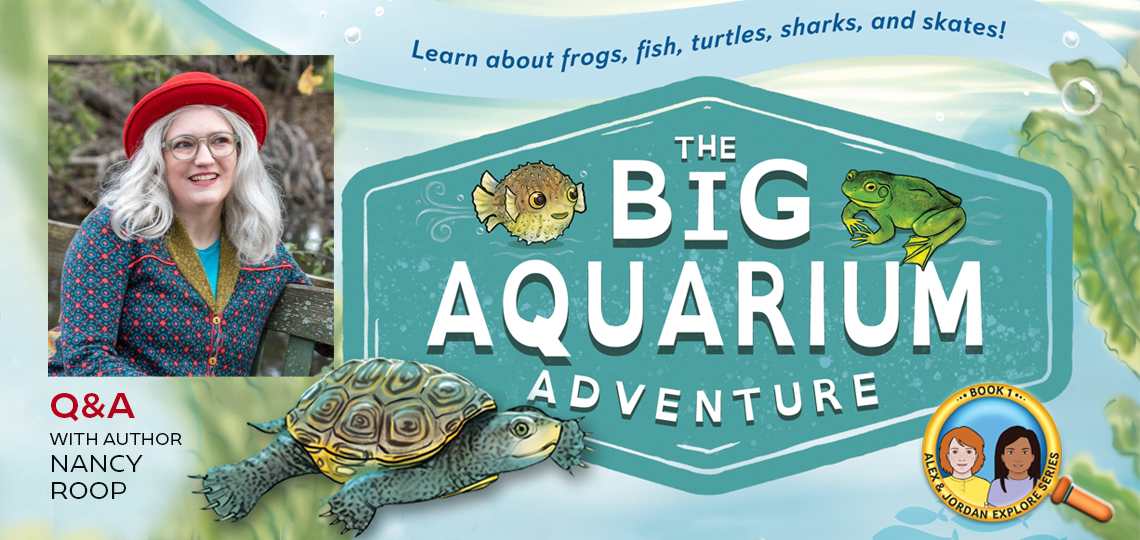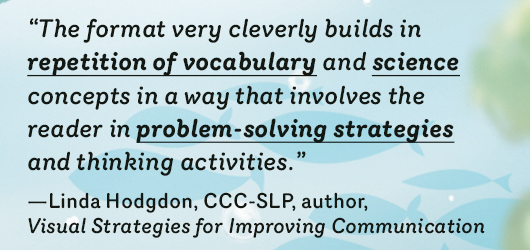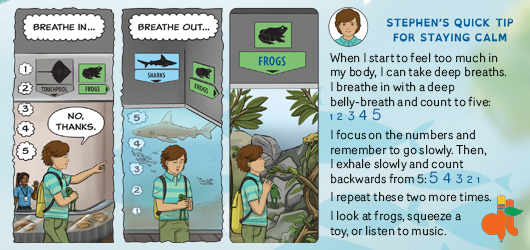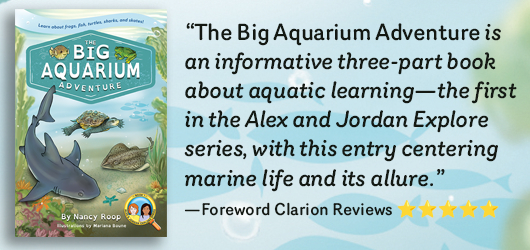It looks like you've stumbled upon a page meant to be read by our code instead of viewed directly. You're probably looking for this page.
Take a struggling reader to a striving reader with The Big Aquarium Adventure!

Executive Editor Matt Sutherland Interviews Nancy Roop, Author of The Big Aquarium Adventure
It’s easy to forget that reading is a skill—now that you can navigate newspapers, novels, street signs, and smart screens with mindless ease. But should you be able to remember those first encounters with c and a and t before a kitty cat pounced into your imagination, you’d realize the path to reading proficiency is long and paved with stumbling blocks. For some, that path is all but impassable.
On the occasion of World Read Aloud Day, early-reader specialist Nancy Roop joins us to talk about the youngsters who struggle to read because they learn differently. She realized that these neurodivergent kids require new tools and teaching methods to earn their reading chops—and that’s exactly why Nancy has made it her life mission to do. The Big Aquarium Adventure is Nancy’s debut in a series of developmentally inclusive books and resources for neurodiverse learners. The book earned a coveted five star Clarion review, which encouraged Foreword’s editorial team to assign Matt Sutherland for an engaging conversation with Nancy.
Enjoy.
First questions first, let’s identify the ideal reader for The Big Aquarium Adventure. How should the book be read (alone, with parents)?
It can be both. I see an eager new reader—one who knows how to read words (able to decode or sound them out)—ready to start early chapter books on their own. These kids love books and love sea animals. They love to dig in and read!
Other kids will benefit from shared reading with adults. These kids may be neurodiverse learners who may struggle with some, or all, of the steps that it takes to read chapter books. They may find any book over ten pages difficult and frustrating.
What is it about early reading that can be frustrating for some children? Can you summarize a few tools parents and teachers can use to help children overcome their reading fears and anxiety?
There are many skills involved with learning to read. First you need to decode the word—what does it say? Then, what does it mean? Many words have multiple meanings, so you need to read and know what the rest of the words mean in a sentence to assign the right meaning to the original word. These words pile up in the working memory, and for some new readers this space is small and some words fall away.
Then, sentences need to make sense with the rest of the sentences within a paragraph—then the page, the chapter, and the book. If one sentence is tough, then a lot are exhausting. An illustrated chapter book allows part of a meaning to be understood by a different part of the brain—no decoding needed, so they are halfway there, just by looking at the page.
Kids often hear that people should love to read, and books are great! I know at school, books are really hyped up, and the messages are good, but they may be overwhelming for some. When every written word is a struggle, they may feel inadequate and may resist books altogether. Instead of talking about how great books are, just model it. Have books for kids and adults sitting around the home, and let your child catch you reading them.
For kids who are not self-starters with a book, repetitive reading is very important. It can start with parent read-alouds by tracking the words with their finger. Kids may glance at it now and then, and that’s ok. Their brain is taking in so much information—let them control how they experience it. Some kids need to play with a small toy while listening. For some, their body needs to move, and if they can’t, they spend all their mind power on sitting still, and not listening to the words.
Overall, by realizing a kid’s resistance is not occurring because they are being defiant, but because reading can be really hard, you can slow down and let them learn on their timeline. It might even mean taking a break for a couple weeks or longer. Also, let them know if you are trying something different, and give them a chance to get used to this new different. For some kids with autism, different, even if easier and more supportive, is still different, and takes time to get used to.
In your “Quick Tips for Adults” section, you point out that “attaching language to the written word while combining the meaning of multiple words to develop new ideas is highly complex.” You centered this book around sea creatures, and plan additional books on zoos, museums, and science adventures. Why these topics? Please talk about the importance of selecting an appropriate subject matter for early and neurodivergent readers.
I choose animals as the first books in the Alex and Jordan Explore series because I know that kids love all kinds of animals. It seems that sea life is very interesting—maybe it is because they live in a totally different habitat than we do. Or that in popular culture, some species have become favorite characters such as frogs, turtles, and sharks.
I also wanted to highlight places that families or school groups can visit because the book can be used as a “what to expect” guide for neurodivergent kids who are visiting an aquarium, zoo, or museum for the first time. With read alouds, shared reading, and then building to individual reading, a child will become familiar with the place and how Stephen was able to keep himself calm when he became startled and fearful. It becomes a real-life lesson, and some kids benefit from books that are real, relatable, and relevant!
Finding books that the child is interested in is always best practice for neurodivergent kids who can sometimes latch on to a subject. It just might tap into self-motivation to find out more by reading more. It’s ok to allow them to go all in—their brain may be wired for that, and it’s good to allow them to really master a book, to build confidence. Just as toddlers like to have the same book read to them over and over, some older children may like that, too. Follow their lead—offer other books, but it’s ok to stick to a couple favorites for a bit. Nonfiction is sometimes a great choice. If you find older nonfiction books, the graphics are not busy, whereas recent books have over the top graphics that can be overwhelming for some.
Alex loves to ask questions and you use his enthusiasm as a great vehicle to teach readers the art of interviewing. Of course, developing sound communication skills requires listening; thoughtful questioning; kindness—as in, showing interest in the thoughts and opinions of others; the importance of sharing one’s own feelings and opinions; and so much more. Can you explain this aspect of the book? With “fake news” and accusations of biased journalism such a hot topic right now, it’s doubly satisfying to see you glorify the skills of reporting.
Alex wasn’t all these things in the beginning, but I love that he became a great role model by asking thoughtful questions and important follow-up questions. He doesn’t judge, and he is respectful, especially when he asks for Stephen’s consent to share his story with Jordan.
I originally wanted a simple way to convey information to readers with a script—meaning the name is at the front of the sentence, so a new reader is not wasting valuable working memory on figuring out who is saying what. Then, the back-and-forth conversation morphed into an interview. It made sense to use this structure to get right to the point of everything. The goal was to provide a way to read important content but with less words to reduce reading frustration for struggling readers. Also, by adding the character icons and the beginning of each question and answer, even less words appear.
In the resources section in the back of the book, I include an activity for kids to interview other kids about a pet or stuffed animal. This allows them to practice social connections as an interviewer, or as the person interviewed. Some kids like to go on about the subjects they know about, and this structure allows both to slow down, and have a back-and-forth conversation. The questions can be downloaded from my website, so the interviewer has their own copy to write on.
Thank you, Matt, for pointing out that this book highlights good practices in journalism.
In addition to Alex asking questions, he knows the next step is doing research and finding out more about a topic. He knows that Jordan loves to research so he asks her to investigate the animals that Stephen talked about.
I just made the connection that journalism and developmental books for neurodiverse learners are alike. Every. Word. Matters. They need to be concise and true. If a struggling reader can only tolerate reading five minutes a day, then what they read is crucial—just like headlines that are blasted around in the media trying to capture people’s attention. Those five minutes need to be authentic and connect to the reader’s life in a meaningful way. If not, it’s just fake nonsense that takes up valuable space in our brains. As I mentioned before, readers need text that is real, relatable, and relevant!
Inspired by Stephen’s trip to the aquarium in Baltimore and Alex’s interview with him, Jordan agrees to research and then prepare a report: “Five Sea Animals that Live in or Near the Eastern USA.” She cleverly displays the information with drawings, headings, diagrams, captions, tables, and a map. So, once again, writing, research, storytelling, fact checking, and other tools of the writing life. Why do you consider writing skills so important.
Schools are now teaching all forms of writing, at earlier ages than we learned. I consider this type of nonfiction—expository nonfiction—especially important for neurodiverse kids because the information is concrete, verifiable, and consistent. They can relate to it and feel more comfortable because they don’t need to determine social norms, whether someone is lying, or deal with changing moods of characters. Fiction can be very confusing, and some may not feel comfortable making stuff up to write a story—they may wonder what’s the point if it’s not true?
When a student loves a topic, they are more apt to dig in deeper with that topic. By creating a nonfiction report, not only are they organizing the information, but they are also writing words. All writing is beneficial. Practicing writing skills is practicing reading skills, because they will need to read what they wrote, as they compile more information. Even labeling an animal’s body parts is important writing. Writing one sentence under a picture is writing a very important sentence. A caption isn’t a paragraph, so it is much easier to master.
All of these skills are transferable to future writing skills that they will continue to develop in school. They are writing single words and sentences, and later they will be writing paragraphs. Right now, the working memory in their brain may only be able to hold one word as they write it because there are many additional skills needed to be able to take independent thoughts and write them down. By practicing with a nonfiction-styled report like Jordan’s, a young researcher can build their confidence with their writing skills.
Another unexpected feature of The Big Aquarium Adventure occurs when Stephen has an anxiety attack at the thought of touching the back of a clearnose skate. He shares his fear openly with Alex and then explains how he used a breathing technique and visualization to get through the episode. In the backmatter of the book, you offer Stephen’s Quick Tip for Staying Calm, with step-by-step guidance. Why did you think this feature is important to readers?
I wanted kids to be able to turn to the back of the book anytime that they wanted to practice the breathing activity, or when they needed it to guide them when they start to feel the anxiety rise inside of them. This image is also available for download. I also wanted to normalize kids talking about their feelings.
The image of Stephen practicing every step of the breathing activity supports students by breaking down each count—each breath. As adults, we can easily see the whole picture of an exercise and understand it. We forget that kids may benefit from a visual image for it to make sense and to see how it works.
Everyone benefits from learning mindfulness activities and self-regulation skills, but neurodivergent people often have more difficulty with self-regulation and keeping anxiety low. Sensory issues, racing thoughts, and confusing situations impact those with autism, ADHD, Dyslexia, brain trauma, PTSD, CPTSD, etc., and the feelings of anxiety may be more intense than their typical peers. By addressing it in the book and including it in the story summary told in first-person (in the resources section), the practice of self-care is reinforced as an important tool for self-regulation.
When I speak at conferences about neurodiversity inclusion, I pull from experience both personally and professionally. Kids are only ready to learn when they are self-regulated. As soon as feelings of anxiety begin, the ability to stay on task starts to wane. I talk about the importance of teaching students the signs of anxiety in their body. Then, how to mitigate it. It is ok to take a break from the task to practice self-care.
Before each chapter you offer a preview of what readers can expect in the following pages—Keywords, Pause and Think Ahead, Pause and Think Back, and mentions of what the characters will accomplish together. As an alternative, you could have offered all of this information in the front of the book in an expanded list of chapters or table of contents. What was your reasoning for spreading it throughout the book?
I wanted the book to have features that mirror what a teacher does during a one-to-one or small group reading sessions. Lessons and knowledge are sprinkled in with conversation before, during, and after a section that is read aloud. It is casual and impactful because it is a back-and-forth exploration of the words on the page. Typically, developing peers can take this model and transfer it to solo reading.
But some kids need more practice time than their teachers can provide. Paraprofessionals, assistants, parents, and other caregivers can do shared reading with this book, and they will have the teaching strategies right there. Since it is part of the natural flow of the book, everyone is just reading and learning new skills. If you were to ask an average adult, “what skills do you use to comprehend what you read,” they probably couldn’t say much more than rereading a section. This book lets them help their child practice comprehension skills with read alouds and shared reading. Then they can try some of these strategies with other books, if they want.
Beyond all the learning stuff, I also wanted the beginning of the book to be accessible to reluctant readers. I eliminated every word that I could. The Pause and Think Ahead ideas for chapter 1 are simple, and then they build through chapters 2 and 3. As mentioned before, chapter 2 is mostly headings, labels, captions, and charts. Background knowledge is key to comprehension of a story, and chapters 1 and 2 provide this information for the story in chapter 3 which has more developed sentences.
Please talk about all the resources you provide at the website nancyroop.com.
There are resources for adults, but first I will explain the Alex and Jordan Kids page because I find that the more a child interacts with a book, the more reading and understanding will occur. I am creating a space where readers can interact with the characters of the book.
It starts with downloadable content like coloring pages, a How-to Interview Guide, and graphic organizers. These may seem simple, but they are meant to stretch your child’s learning based on The Big Aquarium Adventure. Next, the message board is a place where you and your reader can upload pics of their work. Alex and Jordan will respond with encouraging messages.
For adults,I build on the Quick Tips for Adults from the book. I expand the tips that help neurodivergent children with academic strategies and behavior in my blog. Most are less than a five-minute read, and they often include examples in short video clips. I also share my Quick Tips on Instagram, so follow me there to get weekly Quick Tip snippets–IG @developmental_texts, and pics of our four cats!
On the Resources webpage, I have a downloadable brochure that educators can share with families that explain the benefits to reading aloud to children of all ages! This is based on Jim Trelease’s Book, The Read Aloud Handbook. By reading and talking to kids, bonds are built with each other and books. So, I say, “Find a cozy spot and cuddle up with your child—even teens!
What’s next for you and your talented pen? What are you working on?
I am writing The Big Zoo Adventure, and it will have five cool North American animals. With the same developmental format as The Big Aquarium Adventure, readers may feel like it is just another day in Alex and Jordan’s life, and they are exploring a new peer’s trip to The Big Zoo, just like they did with Stephen.
After several titles are complete in the Alex and Jordan Explore series, I will develop a series on researching the same topics. And then, a series on writing. They will relate and build on each other, allowing the reader to feel a little more familiar with the written word.
The team at Developmental Texts is working on a teaching guide for The Big Aquarium Adventure and more free tools are available for download at nancyroop.com.
A personal note about the beautiful side of neurodiverse brains. For ADHD, the ability to hyperfocus and pull information from many areas and synthesize them is a strength.
Nearly six years ago, I had a flash of an idea that someone needed to write books for neurodivergent readers. I realized that I could be that person. So, I enrolled in integrative studies at a local university and created my degree. I researched psychology, linguistics, and literacy while studying creative nonfiction. My thesis, “Developmental Texts for Students with Autism; a Safe Space in the Written World,” is available at nancyroop.com/about. My hyperfocus narrowed to creating a developmental format that centers around reading comprehension.
Since I graduated in April of 2020, I have written The Big Aquarium Adventure, tried to get it published for a year, turned to self-publishing, then realized that Developmental Texts needed to be an independent publishing imprint, so I could develop multiple series for Alex and Jordan for the larger trade market.
Through all of this, I rely on my training and experience from my earlier years as a paraprofessional in an elementary special-education program for students with autism. I learned that a student is not able to learn unless they can self-regulate their sensory, emotional, social, and cognitive needs. I found that a book can be adapted to the reader, so they can practice comprehension strategies on their own or with an adult, just by reading a fun and engaging book that is real, relatable, and relevant!
Please come with Alex and Jordan and explore Stephen’s big adventure!
Matt Sutherland


